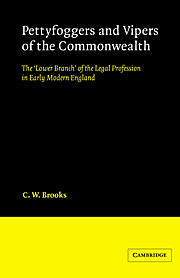 Pettyfoggers and Vipers of the Commonwealth
Pettyfoggers and Vipers of the Commonwealth Book contents
- Frontmatter
- Contents
- List of tables and figures
- Preface
- Abbreviations
- 1 Introduction
- 2 Lawyers and the royal courts in London during the reign of Elizabeth
- 3 The legal profession in the provinces
- 4 The increase in litigation
- 5 The causes of the increase in litigation
- 6 The increase in litigation and the legal profession
- 7 The attitudes of layman and attempts at reform
- 8 Clerkship, the inns of chancery, and legal education
- 9 Private practice
- 10 Public office and politics
- 11 Fees and incomes
- 12 Conclusion
- Appendix: Analysis of the social status of litigants in King's Bench and Common Pleas, 1560–1640
- Notes
- Select bibliography
- Index
- CAMBRIDGE STUDIES IN ENGLISH LEGAL HISTORY
- Frontmatter
- Contents
- List of tables and figures
- Preface
- Abbreviations
- 1 Introduction
- 2 Lawyers and the royal courts in London during the reign of Elizabeth
- 3 The legal profession in the provinces
- 4 The increase in litigation
- 5 The causes of the increase in litigation
- 6 The increase in litigation and the legal profession
- 7 The attitudes of layman and attempts at reform
- 8 Clerkship, the inns of chancery, and legal education
- 9 Private practice
- 10 Public office and politics
- 11 Fees and incomes
- 12 Conclusion
- Appendix: Analysis of the social status of litigants in King's Bench and Common Pleas, 1560–1640
- Notes
- Select bibliography
- Index
- CAMBRIDGE STUDIES IN ENGLISH LEGAL HISTORY
Summary
The subject of this book requires a word of explanation. Essentially, it is a study of the early modern antecedents of that group of English lawyers known today as the solicitors. Unlike the legal profession of the United States, and, indeed, that of many other countries which have been influenced by the common law tradition, English lawyers are divided into two branches which are characterized by different forms of training and regulation and by some very general differences in function. One branch of the profession, the bar, enjoys a monopoly right of audience before the superior courts. The other, the solicitors, provides a wide range of legal services to the community which include conveyancing and advocacy before inferior tribunals such as Magistrates' and County courts. Moreover, since there is a firmly established convention that litigants should not consult directly with barristers without the intervention of a solicitor, the latter also instruct members of the bar in cases which come before the higher courts.
In its modern form, the solicitors' branch of the legal profession is the product of a series of measures passed by Parliament in the 1870s and 1880s which authorized the Law Society to act as the largely self-regulating governing body of the profession. These statutes also greatly simplified its identity. After 1873, a solicitor could be defined easily as anyone who was authorized by the Law Society to practise.
- Type
- Chapter
- Information
- Pettyfoggers and Vipers of the CommonwealthThe 'Lower Branch' of the Legal Profession in Early Modern England, pp. 1 - 9Publisher: Cambridge University PressPrint publication year: 1986
